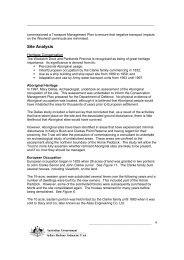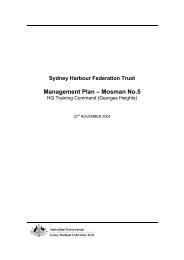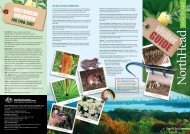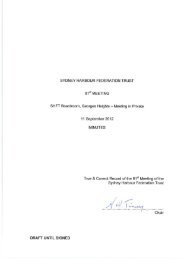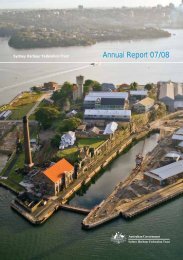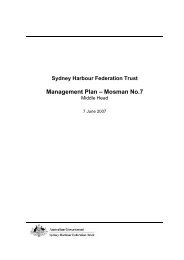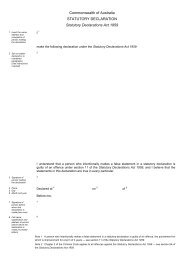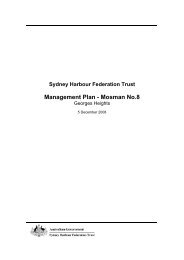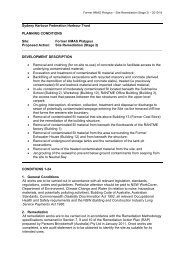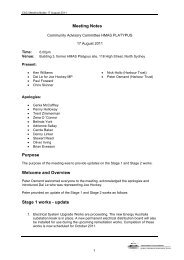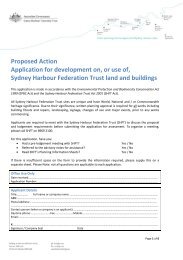PDF - 1.62 MB - Sydney Harbour Federation Trust
PDF - 1.62 MB - Sydney Harbour Federation Trust
PDF - 1.62 MB - Sydney Harbour Federation Trust
- No tags were found...
Create successful ePaper yourself
Turn your PDF publications into a flip-book with our unique Google optimized e-Paper software.
Wildlife Service to provide free training and educationto volunteers on topics such as plant identification,weed management, and native grass identification.The program included a popular Banksia Scrubbushwalk at North Head in September 2006. BirdsAustralia continued bi-monthly monitoring ofbushland at North Head, expanding the knowledgeof avian fauna on this site including the recording ofpreviously unrecorded and rare species. A plantingday was held at Woolwich Dock Goat Paddock onNational Tree Day, 31 July 2006. Twenty-five localvolunteers planted over 300 native tubestock in bareareas of the site.Bushfire ManagementIn the 2006-07 fire season, fuel reduction andslashing of fire breaks and trails were carried outadjacent to buildings and structures at the NorthHead and Mosman bushland sites. A program of fuelreduction and selective clearance of woodyvegetation continues to be carried out within theThird Quarantine Cemetery (North Head) as part ofthe Conservation Management Plan for the site. ANorth Head Bushfire Management Plan wasproduced by NSW National Parks and WildlifeService on behalf of North Head stakeholders in late2006 to guide future ecological burns and hazardreduction activities. The <strong>Trust</strong> revised its BushfireManagement Plan for its Mosman sites to takeaccount of changed land uses. The <strong>Trust</strong> continuedworking with neighbouring landholders through thestatutory Manly-Mosman-North <strong>Sydney</strong> DistrictBushfire Management Committee.Feral Animal ManagementThe <strong>Trust</strong> continued to work with local Governmentand NSW National Parks and Wildlife Service toprovide a co-ordinated approach to management offeral animals at the North Head and Mosman sites.A quarterly program of monitoring and shootingcontinued to reduce rabbit population levels, and the<strong>Trust</strong> continued its involvement in the Northern <strong>Sydney</strong>Regional Fox Control Program. Regular bandicootsurveying by NSW National Parks and Wildlife Servicecontinued across North Head with results showing arelatively stable population size. Feral cats andchickens were also targeted at North Head.Photo: Guided Tour on Cockatoo IslandEcologically Sustainable DevelopmentThe principles of ecologically sustainable development(ESD) constitute a key policy objective of the <strong>Trust</strong>,underpinning site rehabilitation, planning and publicinformation activities. The Comprehensive Plancontains a commitment to ESD, and managementplans are formulated taking into account ESDoutcomes. All <strong>Trust</strong> objectives and policies areconsidered fundamental to the achievement of ESD –including biodiversity conservation, bushlandconservation, management of native and introducedanimals, water quality and catchment protection,transport management and air quality, bushfiremanagement, Aboriginal and cultural heritage.The preparation of management plans for sites andprecincts within sites safeguarded the heritage andenvironmental values of lands in accord with therequirements of the Environment Protection andBiodiversity Conservation (EPBC) Act 1999 and the<strong>Trust</strong>’s ESD policy. Conservation management plans,remediation plans and other project planning allowfor specific ESD objectives to be achieved on aplanned basis. Public programs and communityconsultation continued to emphasise the importanceof the environmental and heritage values of the sites.Planning outcomes provide for maximum publicaccess and the adaptive re-use of <strong>Trust</strong> lands inways that protect and conserve the naturalenvironment and promote ecological sustainability.Site conservation and environmental projects arecarried out to remediate environmental degradationand impacts of past practices to establish a soundbasis for sustainable development and adaptive re-use.Specific examples of projects carried out in thereporting period include:• Ongoing bush regeneration and revegetation;• Preparation of remediation action plan forHMAS Platypus;• Recycling of green waste;• Ongoing removal of pollutant sources includingtanks, lead paint, asbestos and grosscontaminated wastes in pits and lines;• Ongoing recycling of wastes such as metals,timber and demolition product;17 Annual Report 2006-07



